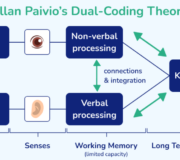Diagnostic Assessment: Your Teaching And Intervention Must Have [+ Free Resources]
Diagnostic assessment is at the heart of good teaching and learning, enabling teachers to create a baseline to monitor student progress and address gaps in students’ knowledge.
While diagnostic assessments may initially seem daunting to some of your students, studies have found that, when used effectively, diagnostic assessment can double the speed of student learning (Black and Wiliam, 2009).
Here we encourage you to understand how you might better use diagnostic assessment with your class and give practical first steps to make it easy and rewarding. As usual, our focus is on maths and we offer many downloadable maths diagnostic assessments, aligned with the English national curriculum, to pinpoint your students’ specific maths gaps.
Diagnostic Maths Assessment
Identify and address learning gaps with your Year 6 class with this set of 4 diagnostic maths assessments on key year 6 maths topics. Each quiz consists of 25 diagnostic maths questions.
Download Free Now!What is diagnostic assessment?
A diagnostic assessment is a type of assessment used to evaluate a student’s strengths, weaknesses, knowledge and skills. The questions are structured to identify a learner’s specific misconceptions. The results are not used for grading purposes, but to make adjustments to the direction of a lesson.
Diagnostic assessments are used widely across primary and secondary schools. They help gather information about how students have understood the lesson content, and where to modify the learning process.
They can be used in every school year and at any stage of the learning process including:
- pre-assessment
- end-of-unit test
- during a lesson
Why is diagnostic assessment key to pupil progress?
Diagnostic assessments provide instant feedback on each pupil’s learning, enabling teachers to decide how to proceed and adapt their lesson plans accordingly.
As such, these assessments are essential to improving learner outcomes. They can increase the speed and effectiveness of learning by:
- Reducing the time spent teaching information that students already know
- Directly challenging the most common misconceptions held in a class
- Identifying students who require a small-group intervention or revision programme
The importance of diagnostic assessment
- Diagnostic assessments are quick for students to answer, meaning they can be incorporated frequently into every lesson.
- It is possible to get responses from every pupil in the class simultaneously
- Each wrong answer reveals a misconception without requiring further explanations
- Teachers know which misconceptions need to be challenged
- Teachers can assess prior knowledge and save time by only teaching the topics required
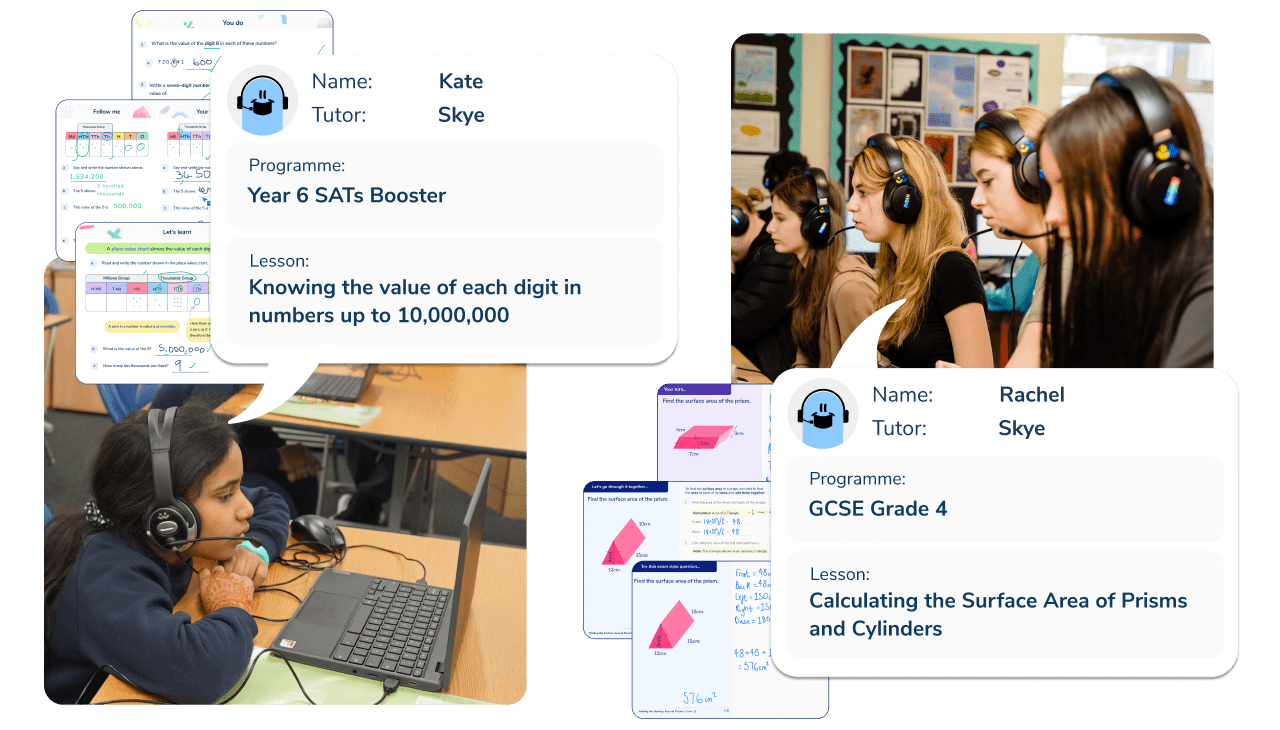
Meet Skye, the voice-based AI tutor making maths success possible for every student.
Built by teachers and maths experts, Skye uses the same pedagogy, curriculum and lesson structure as our traditional tutoring.
But, with more flexibility and a lower cost, schools can scale online maths tutoring to support every student who needs it.
Watch Skye in actionCommon diagnostic assessment tools
The most appropriate format for a diagnostic tool will vary between subjects and depend on the learning.
Generally in maths, multiple choice quizzes (including hinge questions) are the most common type of diagnostic assessment.
Other types of assessment such as open-ended questions, practice tests, reading assessments, worksheets etc may identify gaps in knowledge or understanding but they are less likely to be able to pinpoint specific misconceptions.
Applying the principles of formative assessment
When deciding which tool to use, teachers should consider the three guiding questions of formative assessment and the follow-up questions associated with each one:
Where are we going?
It is important for teachers to consider this question before beginning a lesson or series of lessons and to be clear about the learning goals for their students.
- What were the learning objectives for the lesson or this part of the lesson?
- What do I expect students to have achieved at this point?
Where are we now?
Formative assessment can then be used as a low stakes check throughout each lesson to effectively measure the learners’ understanding. By asking the question: “Where are we now?” we can determine how effective the learning is and look to incorporate actions to improve it as required
- What questions can be asked to know whether the learning objectives have been met?
Where should we go next?
While all formative assessments are designed to answer the third question, a diagnostic assessment allows you to address this more forensically.
You might get a general idea that pupils can’t add fractions from a non-specific formative assessment question, but a diagnostic question could tell you the reason they’re struggling.
For example, perhaps they’re not identifying the lowest common denominator because they don’t know their times tables.
Identifying learners’ misconceptions, allows teachers to make informed decisions about the most appropriate course of action to improve learning.
- What misconceptions might students have?
- How will their answers reveal these misconceptions?
- What type of question (e.g. open or closed) will provide answers that I can translate into misconceptions?
Read more: Formative and summative assessment
Best examples of diagnostic assessment
Multiple-choice questions are usually the most effective form of diagnostic assessment. Each incorrect answer can be chosen to reveal a specific maths misconception and the question can be designed so that students can only answer it correctly if they do not hold a misconception related to that topic.
The discrete list of answers makes it quick for the teacher to mark and students can receive quick feedback about their understanding.
Many dignostic assessments can be completed by students in no more than ten seconds, which means that they can be used frequently throughout every lesson without sacrificing valuable learning time.
Frequent diagnostic assessments help learners become more reflective and identify which topics require greater revision.
DIAGNOSTIC ASSESSMENT WITHIN THE TUTORING PROGRAMME
Third Space Learning sessions start with an open-ended assessment question called “Skill Check In”, which is designed to diagnose the pupil’s understanding of that topic and ensure their lesson is tailored to their needs.
If the pupil shows they are not yet secure with that topic, Skye, our voice-based AI tutor that is trained using human expertise, provides scaffolded support: modelling a similar example, working through guided questions, and gradually moving them toward independent practice and challenge. On the other hand, if the pupil demonstrates secure understanding, Skye moves straight to the application and challenge parts of the lesson.
The pupil is then asked another open-ended question at the end of the session to evaluate what they have understood.
Skye also assesses pupils’ understanding throughout a lesson. Skye is trained to do this through general assessment for learning or formative assessment, rather than anything strictly diagnostic.
Teachers can adjust the sequence of lessons at any point during the programme, using insights from these in-lesson assessments to target learning gaps as they emerge.
Here’s an example of a Skill Check In slide from a Third Space Learning’s primary lesson:
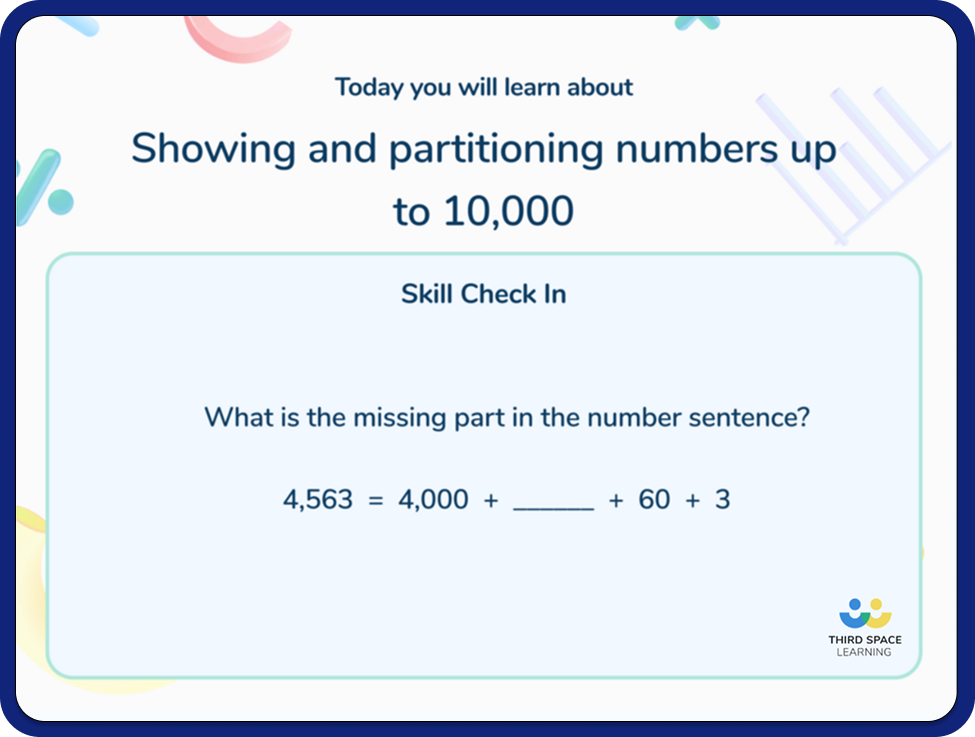
READ MORE: Third Space Learning Diagnostic Assessment
Free diagnostic assessments
KS2 maths diagnostic assessments
Third Space Learning has created over 50 diagnostic quizzes for Years 1 to 6 covering all key topics:
- number and place value
- four operations
- measurement
- geometry
- ratio and proportion
- algebra
- fractions decimals and percentages
- addition and subtraction
- multiplication and division
Each diagnostic maths assessment includes a detailed mark scheme that indicates the correct answer and explains the distractor answers and misconceptions.

Download yours free here: Number and Place Value Diagnostic Assessments
- Year 6 Diagnostic Maths Test
- Year 5 Diagnostic Maths Test
- Year 4 Diagnostic Maths Test
- Year 3 Diagnostic Maths Test
- Year 2 Diagnostic Maths Test
- Year 1 Diagnostic Maths Test
You can download further diagnostic assessments with a premium subscription from the Third Space Learning online maths hub.
KS3 and KS4 maths diagnostic assessments
For students in key stages 3 and 4 there are over 60 packs of diagnostic maths questions for
- number
- geometry
- ratio and proportion
- algebra
- statistics
- probability

Each free pack of diagnostic questions contains twenty multiple-choice questions relating to the key skills required to master the GCSE topics. The incorrect answers have all been carefully selected to highlight a specific misconception, meaning that subsequent teaching can be targeted to improve learning and understanding most efficiently.
Hundreds more free KS3 and KS4 resources are available from the secondary maths resource library.
Advantages and disadvantages of diagnostic assessment
Advantages of diagnostic assessment
Diagnostic assessment using multiple choice questions allows teachers to quickly and accurately assess students’ understanding and get valuable information about the misconceptions causing a barrier to learning.
When teachers challenge these misconceptions and use students’ answers to make decisions about the next stage of the lesson, learning moves forward faster than it would have in the absence of the diagnostic assessment.
This is a huge advantage as lesson time is more effective when teachers focus on knowledge gaps rather than reteaching information the class is secure with.
Disadvantages of diagnostic assessment
Diagnostic assessments can be time-consuming to create. Experienced teachers may find it easier to create diagnostic assessments as it requires subject-specific pedagogical knowledge to accurately identify potential misconceptions and write questions that can reveal these.
Plan for the next steps once a diagnostic assessment reveals a misconception. For example, do you reteach to all the students in a group or just specific pupils?
Schools may need to invest money in teachers’ professional development to enhance the impact of diagnostic assessment. Ensure teachers are skilled to challenge misconceptions and move learning forward.
This can also be mitigated by sharing resources with colleagues and through online professional communities.
What makes a good diagnostic assessment?
When designed effectively, each incorrect answer reveals a different misconception about the assessed topic. This makes it easy for teachers to analyse the results and adapt their teaching accordingly.
A good diagnostic assessment will allow teachers to confidently make decisions about how to proceed with the next stage of their lesson or how to begin the following lesson.
Features of effective diagnostic assessments
- Questions are clear and unambiguous (often closed and multiple choice)
- The focus of the assessment is on one single skill or concept
- Students’ incorrect answers reveal their misconceptions without the need for further explanation
- The correct answer cannot be reached if students hold a misconception
- Students can answer each diagnostic question in less than ten seconds
How to use diagnostic assessment to inform ongoing teaching
To improve learning, teaching must be adaptive and tailored to students’ needs. Diagnostic assessment provides teachers with the tools to do this quickly and effectively when three key practices are followed (Andrade & Heritage, 2017).
- Integrate the assessments into the process of teaching and learning
- Use students’ responses to move learning forward
- Design the assessments to support student self-regulation
1. Integrate the assessments into the process of teaching and learning
Diagnostic assessments can be effectively used in every school year and at every stage of the learning process as required by a teacher to inform their decision making process.
Before starting a lesson, a diagnostic test can be used as a pre-test to assess prior learning. Further assessments throughout the lesson and at the end of the lesson can be used to assess the effectiveness of the teaching strategies and instruction.
When diagnostic questions are used throughout every lesson, they must be quick to execute and not create a distraction from the learning activities. Popular approaches include:
- Presenting multiple choice questions on a PowerPoint presentation
- Giving students an entry ticket or worksheet to answer the question on
- Asking students to write their answers on mini-whiteboards
- Numbering multiple choice questions from 1 to 4 so that students can hold up the number of fingers that corresponds to their answer
2. Use students’ responses to move learning forward
The purpose of a diagnostic assessment is to enable teachers to make an informed decision about the best course of action for the next stage of learning. It is only possible to do this effectively if:
- The diagnostic assessment is designed to diagnose students’ misconceptions effectively
- The classroom culture supports students to complete the diagnostic assessments honestly
- Teachers have sufficient training to move learning forward once they have identified their students’ misconceptions
The assessment method a teacher uses should be tailored to each class. For example, students who are nervous about giving an incorrect answer, being allowed to give their answer non-verbally and not written down can give them the confidence to attempt each question. Asking students to hold up the number of fingers (1, 2, 3, or 4) that corresponds to their multiple-choice answer is an effective way of helping students who lack confidence.
The classroom culture you create can also support students to answer diagnostic questions honestly and not opt out. Teachers should aim to create a shared mindset that incorrect answers represent a learning opportunity. This mindset can be encouraged by teachers referring to incorrect answers as misconceptions and sharing the purpose of diagnostic assessments with their students.
Teachers also need the training and skills within their CPD to know what to do with the results of the diagnostic assessment – as well as how to create them
- Educating teachers about the importance of using diagnostic assessment to move learning forwards
- Providing teachers with the pedagogical knowledge required to create effective diagnostic questions
- Increasing access to teaching resources and a range of teaching strategies to challenge students’ misconceptions
3. Diagnostic assessments should provide learning opportunities for students
Incorporating diagnostic assessments into lessons and providing students with instant feedback about their learning will improve metacognition and their ability to self-assess.
Referring to incorrect answers as misconceptions will reinforce the message that diagnostic assessments provide valuable information about students’ knowledge and current understanding. This can include whole class feedback where students have the opportunity to respond to teacher feedback on their work together.
4. Add in a confidence weighting from the students
Another good metacognitive strategy when using diagnostic assessments is to ask students to rate how confident they are in their answers before revealing the correct answers. While this encourages students to reflect on their answers, it also enables teachers to take advantage of the hypercorrection effect: when a student is confident about an incorrect answer, they are more likely to get the answer right in subsequent tests.
Providing a confidence rating does not need to add very much time to complete a diagnostic assessment; students can just write down a number between 1 and 5 to represent how confident they are or indicate which emoji is most representative of their confidence.
Diagnostic assessment FAQs
Diagnostic assessments are a type of formative assessment. They are designed to improve learning rather than just provide an evaluation of learning.
The purpose of a diagnostic assessment is to improve learning by identifying students’ misconceptions and making these explicit to the teacher.
Each question within a diagnostic assessment should take no more than ten seconds for a student to complete.
Diagnostic assessments should be conducted throughout every lesson, at each stage of the learning process, and whenever a decision needs to be made by the teacher about what should happen next in the lesson.
References
Andrade, H.L. and Heritage, M., 2017. Using formative assessment to enhance learning, achievement, and academic self-regulation. Routledge.
Wisniewski, B., Zierer, K. and Hattie, J., 2020. The power of feedback revisited: A meta-analysis of educational feedback research. Frontiers in Psychology, 10, p.3087.
DO YOU HAVE STUDENTS WHO NEED MORE SUPPORT IN MATHS?
Skye – our AI maths tutor built by teachers – gives students personalised one-to-one lessons that address learning gaps and build confidence.
Since 2013 we’ve taught over 2 million hours of maths lessons to more than 170,000 students to help them become fluent, able mathematicians.
Explore our AI maths tutoring or find out about maths intervention programmes for your school.
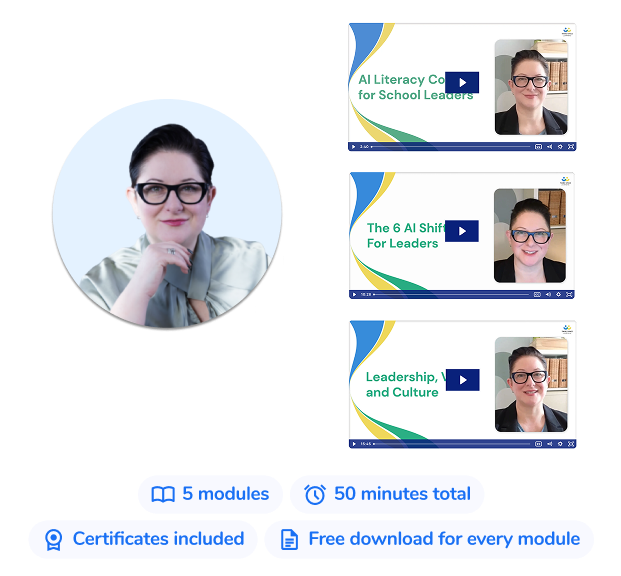

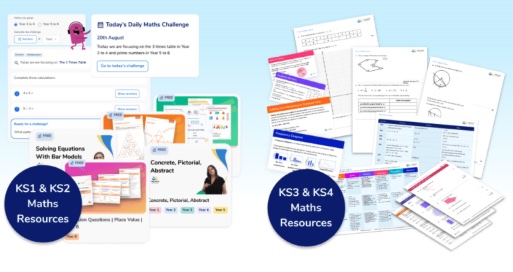
![Diagnostic Assessment: Your Teaching And Intervention Must Have [+ Free Resources]](https://thirdspacelearning.com/wp-content/uploads/2018/07/Set-of-4-diagnostic-quizzes-year-6-RL-image.png)


